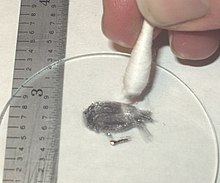
Back غالينستان Arabic Галинстан Bulgarian Galinstan Catalan Galinstan Czech Galinstan German Galinstano Spanish Galinstan Basque گالینستن Persian Galinstaani Finnish Galinstan French
| Galinstan | |
|---|---|
 Galinstan from a broken thermometer, appearing to wet a piece of glass | |
| Physical properties | |
| Density (ρ) | 6.44 g/cm3 (at 20 °C) |
| Thermal properties | |
| Melting temperature (Tm) | -19 °C |
| Specific heat capacity (c) | 296 J·kg−1·K−1 |
| Sources[1][2][3] | |
Galinstan is a brand name for an alloy composed of gallium, indium, and tin which melts at −19 °C (−2 °F) and is thus liquid at room temperature.[4][5] In scientific literature, galinstan is also used to denote the eutectic alloy of gallium, indium, and tin, which melts at around +11 °C (52 °F).[5] The commercial product Galinstan is not a eutectic alloy, but a near eutectic alloy.[5] Additionally, it likely has added flux to improve flowability, to reduce melting temperature, and to reduce surface tension.[5]
Eutectic galinstan is composed of 68.5% Ga, 21.5% In, and 10.0% Sn (by weight).[6]
Due to the low toxicity and low reactivity of its component metals, galinstan has replaced the toxic liquid mercury or the reactive alloy NaK in many applications[which?].
- ^ Hodes, Marc; Zhang, Rui; Steigerwalt Lam, Lisa; Wilcoxon, Ross; Lower, Nate (2014). "On the Potential of Galinstan-Based Minichannel and Minigap Cooling". IEEE Transactions on Components, Packaging and Manufacturing Technology. 4 (1): 46–56. doi:10.1109/tcpmt.2013.2274699. ISSN 2156-3950. S2CID 30876603.
- ^ Cite error: The named reference
scitoyswas invoked but never defined (see the help page). - ^ Cite error: The named reference
melt and boil pt.was invoked but never defined (see the help page). - ^ Surmann, P; Zeyat, H (Nov 2005). "Voltammetric analysis using a self-renewable non-mercury electrode". Analytical and Bioanalytical Chemistry. 383 (6): 1009–1013. doi:10.1007/s00216-005-0069-7. PMID 16228199. S2CID 22732411.
- ^ a b c d Handschuh-Wang, Stephan; Gan, Tiansheng; Rauf, Muhammad; Yang, Weifa; Stadler, Florian J.; Zhou, Xuechang (December 2022). "The subtle difference between Galinstan and eutectic GaInSn". Materialia. 26: 101642. doi:10.1016/j.mtla.2022.101642. S2CID 254003580.
- ^ Liu, Jing (2018-07-14). "Ch 5 Preparations and Characterizations of Functional Liquid Metal Materials". Liquid metal biomaterials : principles and applications. Yi, Liting. Singapore. p. 96. ISBN 9789811056079. OCLC 1044746336.
{{cite book}}: CS1 maint: location missing publisher (link)
© MMXXIII Rich X Search. We shall prevail. All rights reserved. Rich X Search